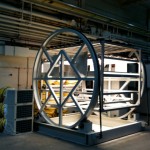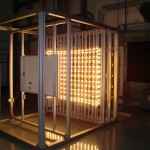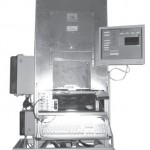Application
IMT has been building quality and dependable Sun Simulators for our customers since 1993. While many of these systems where designed to custom specifications for our clients with Photovoltaic or Solar Thermal testing needs, it is important to know we have a series of standard packages ranging from the Mini-Susi (used for PV cell R&D and testing) to the Lab Production SUSI enabling the testing of large PV and Thermal Panel Products. Designs incorporating both vertical and horizontal light paths are common – but so too are options like cold sky, 45 degree tilt beams/beds and even variable irradiance output capability to provide ranges from 200 to 1100w/m2 in one Simulator.
Unlike some companies that only specialize in selling “lighting” equipment, IMT has been actively involved in helping manufacturers make better solar related products while at the same time working side by side with testing labs and institutes to help better understand and develop credible testing parameters. Th is expertise allows us to offer rare and valuable customer service as part of the important support you can expect when your organization chooses IMT for its equipment needs. Remember, our Steady State Sun Simulators are just one part of a complete line of Solar Quality Control Products including Silicon Irradiance Sensors, PV I-V Curve Tracers and Data Loggers; equipment all designed to stand alone – or work together as one highly effective integrated system for your organization.
The Mini-SUSI
The Mini-SUSI is a small low cost steady-state sun simulator that has been designed to support research and development of Photovoltaic(PV) cells of all types as. It also works in a Quality Control role testing products for PV cell manufacturers or PV Cell purchasers (typically module manufacturers). Th e System’s design can be specified by the customer for ideal test plane size, irradiance homogeneity class (temporal and local) and can also be configured with or without a cell heating block. In most applications the Mini’s steady-state light source combined with our PV-KLA cell I-V curve tracking systems allows the owner to make Normal Operating Cell Temperature (NOCT) measurements also enabling cell temperature coefficients to be easily and accurately measured. Th e cells I-V curve can also be measured and STC values automatically calculated all thorough our easy to use IMT “PVK” software.
SUSI Models
Historically the basic advantage of large Steady State Sun Simulators was that if properly designed, they were rugged, easy to maintain and cost effective to operate. Today these advantages have grown. Unlike any type of “fl ash” or “pulse” solar simulation, the modern IMT Steady State Sun Simulator (SUSI) enables the user to test a wide variety of materials and at various irradiance output levels (including spectrum and homogeneity). As scientific advances in specialized high-tech materials continue to evolve, the ability to adjust or adapt a professional SUSI for use in the “future” may be possible – unlike fl ash systems that once built, are forever basically limited to only one operations mode.
IMT Steady State Sun Simulators feature integrated computer control and second to second intelligent irradiance feed- back with self adjusting operation to yield the test plane the maximum level of consistency possible. These features also promote the health and life cycle of the lamp, realizing IMT equipment’s cost-effciency and operational advantages.
Like the smaller “Mini”, all of our Steady State Sun Simulator’s design and operation parameters can be specified by the customer for ideal test plane size, irradiance homogeneity class (temporal and local) and can also be configured on various light beam paths (horizontal, vertical or angled) as well as with or without cold sky. And again, for PV testing applications, the IMT SUSI when combined with the PV KLA I-V Tracer system, allows photovoltaic module testing to be systematic, accurate and cost efficient.
Steady State Sun Simulator (SUSI) Specifications
General Information
- Temporal Inhomogenity: Class A (+/- 0.2% or better)
- Local Inhomogenity: Class B (+/-5%)
- Spectral Match: Class C or Class B (AM1.5G)
- Maximum Irradiance level at test plane: 1100W/m2 Max
- Irradiance level adjustment Range: 750 to 1100W/m2, 200 to 1100W/m2 also available
- Test bed size: User defined
- Lamps Type: Halogen Reflector, color corrected
- Estimated Number of Lamps: Number is determined by numerical simulation of irradiance field for the requested test plane size.
- AC Power supply: 3 Phase AC, Voltage and phase configuration
- DC Power supply output: 20 VDC max, Lamp drive controlled between 12 and 19 volts.
- Simulator System Control: Supplied PC with 15” touch screen monitor
- External PC communication interfaces: RS-232C, Ethernet network connection, USB 2.0 port
- Simulator Control software: Developed using National Instruments LabView™ Ver 8.X
- On site Setup: Uses aluminum profiles for open frame
- Irradiance Orientation: Horizontal or vertical or custom axis
- On site calibration and verification of: Spectrum and Irradiance uniformity
MINI-SUSI Specifications and Options
General Information
- Complete system including IV curve analyzer for testing of PV cells
- Irradiance homogeneity class can be specified as A, B or C
- Spectrum class: C or B
- Lamp Type: Philips 13117
- Number of lamps used is defined by test plane area
- Power supply: 17 VDC (variable ±10 %), switching unit with PFC
- Irradiance in test plane adjustable from 200 to 900W/m2
- Lamp Cooling: One fan for every lamp
- Lamp Protection: Forced starting of fans before switching-on of the lamps
- Integrated Silicon Irradiance Sensor; Si-01TCext with temperature compensation.
- LED Displays: Lamp Voltage, Irradiance in test plane
- Electromechanically driven operational hours indicator
- PV cell test plane tray with ball bearing slide
- Supplied with heavy duty casters for ease of moving of system in test area
- Construction: Rugged and stable aluminum structural framing and side panels
Optional Equipment
- PV-KLA IV curve tracing system with cell adapter and cell temperature sensor
- IV measurement ranges may be specified by the customer
- On site Irradiance and spectrum calibration/verification
- Cell heating block
- Fast response RTD cell temperature sensor class A or B
- Data logging system for Irradiance, cell Voltage, cell Current and cell Temperature
- Integrated computer system with small touch screen display



